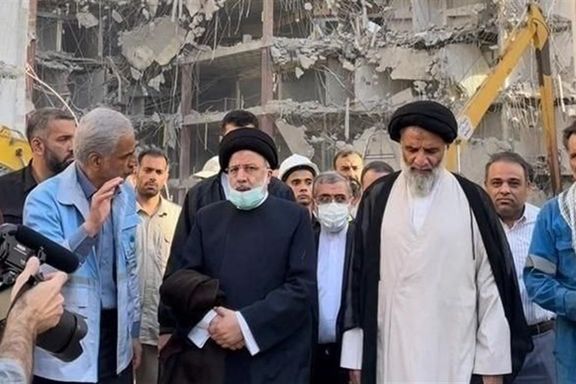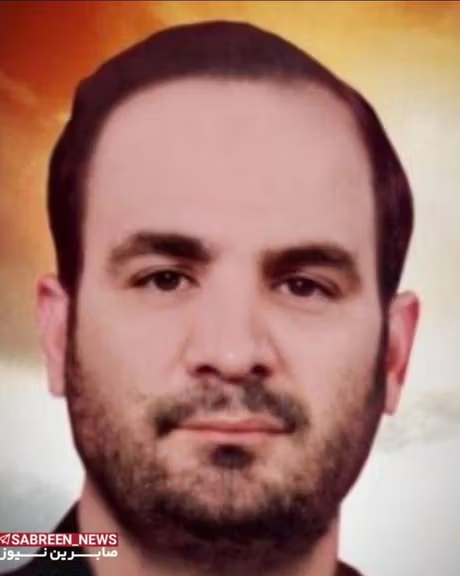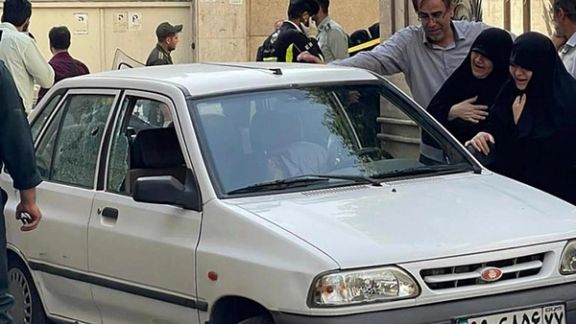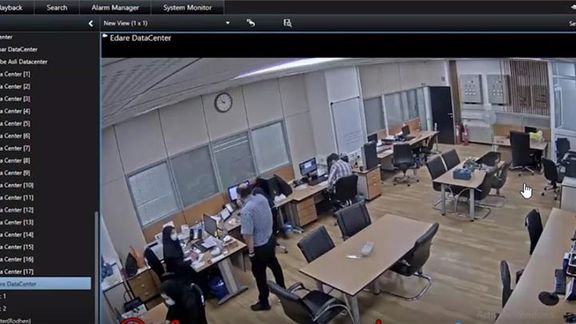President Raisi Pays Quiet Visit To Restive Abadan

Following days of anti-government protests and a heavy-handed crackdown in Iran’s province of Khuzestan, following the deadly collapse of a building, President Ebrahim Raisi paid a visit to Abadan.

Following days of anti-government protests and a heavy-handed crackdown in Iran’s province of Khuzestan, following the deadly collapse of a building, President Ebrahim Raisi paid a visit to Abadan.
Unlike normal visits by the president to other cities, which are usually announced beforehand so local authorities can organize state-sponsored welcoming ceremonies, the Friday junket was without the presence of people except for his security detail and a couple of city officials.
Protests began last week, when the 10-story Metropol building collapsed, leaving nearly 40 people dead and dozens missing. It quickly became apparent that the owner and builder was a powerful and well-connected businessman who had disregarded regulations and building codes, being backed by officials, who might have had their own financial interests.
He also visited homes of some families of the victims of the disaster that triggered protests in Abadan as well as in several other cities across the oil-rich Khuzestan province who have been taking to the streets to demand accountability.
During the visit, Raisi said people have the right to expect investigation into corruption and some businessmen's connections with authorities that led to the Abadan incident, adding that they should be dealt with quickly.

Iran says the members of the Persian Gulf Cooperation Council (GCC) are in no position to comment about Iran’s military policies, particularly its missile program.
Iranian Foreign Ministry spokesman Saeed Khatibzadeh on Thursday rejected remarks in a statement issued at the end of the 152nd session of GCC's Ministerial Council in Saudi Arabia's capital Riyadh on Wednesday.
In their statement, the GCC described Iran’s nuclear and missile programs and regional strategies as the main “challenge” facing the member states, criticizing the Islamic Republic’s support for “terrorism” as well as its “destabilizing behavior” across the region.
Khatibzadeh said such a "threadbare and destructive” statement indicates a “completely wrong approach” adopted by some member states and their “strategic confusion” vis-à-vis the Islamic Republic.
Iran and Saudi Arabia have held several rounds of talks since 2021 to improve their ties, severed since 2016, with no major results so far.
Commenting on the request by some GCC member states to be part of the Vienna talks to revive the 2015 Iran nuclear deal, JCPOA, Khatibzadeh said raising such issues demonstrates the depth of the council’s failure to see the realities as the JCPOA and the UN Resolution 2231 have made it clear which countries are the signatories to the international treaty and can take part in the negotiations.

Iranian government and IRGC media have confirmed the death of a Quds Force colonel after Iran International reported the suspicious incident on Thursday.
Iran’s official government news website IRNA reacted to the news saying that Col. Ali Esmailzadeh died “in an incident in recent days” at his home without mentioning any details. It added that an investigation is in progress, quoting “an informed source”.
IRNA rejected any suggestion of an assassination and called such reports “psychological ops” and “manufacturing news”.
Iran International, quoting sources in Iran, first reported Thursday that Esmailzadeh, one of the commanders of a secretive IRGC Quds (Qods) unit fell from the rooftop of his house in Karaj, near Tehran and was pronounced dead in the hospital. He served in Unit 840 of the extraterritorial Quds Force that conducts operations abroad, often directed against US allies in the region.
The incident happened on Monday, May 30, eight days after another commander Hassan Sayyad-Khodaei of the same secretive Unit 840 was assassinated outside his home in Tehran by two assailants who escaped on a motorcycle.
The sources said that after the assassination IRGC intelligence organs became suspicious of Esmailzadeh, who was a close associate of Sayyad-Khodaei and decided to eliminate him. They told his family that the victim committed suicide because he was suffering psychologically after a divorce.
Sabereen News, an Arabic and Persian Telegram channel close to the Qods Force also confirmed Esmailzadeh’s death saying that “he fell from the balcony” at his home.
But in its first report Sabereen News had called the incident “suspicious” and said, “investigations have begun,” asking the public not to believe “opposition” media, insisting that “so far nothing is clear.”
A few hours later, the IRGC-controlled channel quoted “an informed source” denying “assassination” as the cause of Esmailzadeh’s death.
But confusion reigned as another IRGC-affiliated channel, Ammariyoun, first said in a post, “It is being reported that another member of the Guards Qods Force has been assassinated.”
A few minutes later, the post was deleted, and the channel replaced the word “assassination” with “suicide” and wrote, “It is being reported that a person with the name Colonel Ali Esmailzadeh committed suicide by falling at his home in Karaj.”

Iran International’s sources in Iran say that another commander of IRGC Quds Force unit 840 died under suspicious circumstances in Karaj on Monday, May 30.
The sources said that Colonel Ali Esmailzadeh died when he fell from the roof of his home in Jahan Nama area of Karaj.
He was a close colleague of Colonel Hassan Sayyad-Khodaei, the acting commander of the elite Qods Unit 840, who was shot dead behind the wheel of his car outside his home in Tehran on May 22 by two gunmen who fled the scene on a motorbike.
Unit 840 is a very secretive group within the Quds Force and there are no photos of its members available.
Iran International’s sources also said that after he fell from the roof, Esmailzadeh was taken to Shahid Madani hospital where after examination doctors pronounced him dead. Based on this report, officials of the Revolutionary Guard (IRGC) told Esmailzadeh’s family that the reason for his death was suicide. The IRGC officials further told the family that he ended his life due to psychological problems after separation from his wife and has left a note about his action.
A European security source last week had told Iran International that Col. Sayyad-Khodaei, who was assassinated eight days earlier, was in charge of planning terror operations outside Iran, including attacks in India, Taiwan, Cyprus and Georgia. Suspicions for his assassination fell on Israel and according to some reports, Israeli officials told the United States that they had targeted Sayyad-Khodaei.
In the case of Esmailzadeh, Iran International’s sources said that after Sayyad Khodaei’s killing the IRGC intelligence looking for security leaks from within the Qods Force became suspicious of Esmailzadeh and decided to eliminate him by organizing a suicide scenario.


An Iranian hacktivist group named ‘Uprising till Overthrow' has hacked into and deactivated over 5,000 surveillance cameras and 150 websites and online services of Tehran Municipality.
The largescale cyberattack occurred on Thursday on the eve of commemoration ceremonies for the death anniversary of the late founder of the Islamic Republic Ruhollah Khomeini. The security cameras around his mausoleum were also deactivated.
The hacktivist group, reportedly affiliated with the Albania-based opposition Mujahideen-e Khalq (MEK) group, put photos of the leaders of the group Massoud and Maryam Rajavi as well as insults at Khomeini, Supreme Leader Ali Khamenei, and President Ebrahim Raisi on the websites of Tehran Municipality.
The MEK released a video clip it claimed showed the websites defaced with a graphic that criticized the Iranian leaders, with an image of Khamenei with a red 'X' over his face, while calling for an “uprising until overthrow.”
A spokesman for the MEK told Iran International that over 600,000 text messages saying “Death to Khamenei” and “Damn You Khomeini” were also sent to Iranian citizens today.
The Municipality of Tehran confirmed the attack, saying the “intentional disruption” of its portals resulted in display of “insulting” images on its websites.
The hack comes after another cyberassault in March on the portal of the Ministry of Culture and Islamic Guidance (Ershad) and its affiliated websites showing the photos of the Rajavis and calling for the death of the country’s supreme leader.
After a similar attack in January, a MEK spokesman said a ten-second hacking of several television and radio channels of Iranian state broadcasting might have been done by supporters in Iran. The hackers put up pictures of the Rajavis, and one of Khamenei in a gun sight. The Iranian leader was badly wounded in 1981 in one of many bombings attributed to the MEK.
On February 1, Hacktivist group Edalat-e Ali (Ali's Justice) hacked the online streaming of Iran’s state television and broadcasted a video with a strong opposition message. The video started with footage of people in Tehran’s Azadi stadium shouting “death to dictator” referring to Kamenei, then it cut into a close up of a masked man similar to the protagonist of the movie V for Vendetta, who said “Khamenei is scared, the regime’s foundation is rattling”.
In August 2021, a mystery hacktivist group calling itself Tapandegan (Palpitations), previously known for the 2018 hacking of electronic flight arrival and departure boards in Mashhad and Tabriz, released security camera footage from Tehran's Evin prison. Tapandegan said the images came from hackers called Edalat-e Ali (Ali's Justice) and were being circulated to draw attention to prisoner abuse.
In October 2021, gas stations in Iran were hit by an attack disrupting payments, leading to long queues for two days that prevented customers using the government-issued electronic cards for subsidized fuel. ‘Predatory Sparrow’ claimed responsibility, but Iranian officials blamed outside forces, widely taken to refer to Israel.
While Masoud Rajavi is widely thought dead, the MEK insists he is merely in hiding waiting for his return to Iran. The MEK allied to Saddam Hussein during the 1980-88 Iran-Iraq war and helped the Iraqi dictator put down the 1991 uprisings in Iraq, when tens of thousands died.
The MEK was listed by the US from 1997 to 2012 as a ‘foreign terrorist organization,’ but was subsequently removed from the list. The group has cultivated links with many politicians in the US and Europe, paying large sums for attendance or speeches at its rallies.

TankerTrackers has located two Greek oil tankers seized by Iran last week, saying Delta Poseidon is held north of Larak island and Prudent Warrior is held in Bandar Abbas.
The independent monitoring service, which tracks and reports shipments and storage of crude oil, said in a Twitter post on Thursday that they have a visual confirmation the hijacked Greek Suezmax tanker Prudent Warrior is in the anchorage of Bandar Abbas in the southern Hormozgan province and the other Suezmax vessel, the Delta Poseidon is being held north of Larak island near the Strait of Hormuz.
The Iranian Revolutionary Guards' navy seized the two vessels during helicopter-launched raids on May 27 in the Persian Gulf, a week after the confiscation of Iranian oil from a tanker held off the Greek coast and its transfer to the US.
Criticized by many former and current officials as well US congresspeople for a lenient Tehran diplomacy that has led to the increase of the Islamic Republic’s oil revenues, President Joe Biden’s administration has apparently stepped up its effort to put pressure on Iran’s crude exports, which have been sanctioned since the former President Donald Trump abandoned the nuclear deal in 2018.
The Vienna talks to restore the 2015 nuclear deal have stalled mainly because of Iran’s demand for the US to remove the Revolutionary Guard (IRGC) from its terrorism list (FTO) and the recent missile attacks have shed more doubts whether Washington would take such a step.